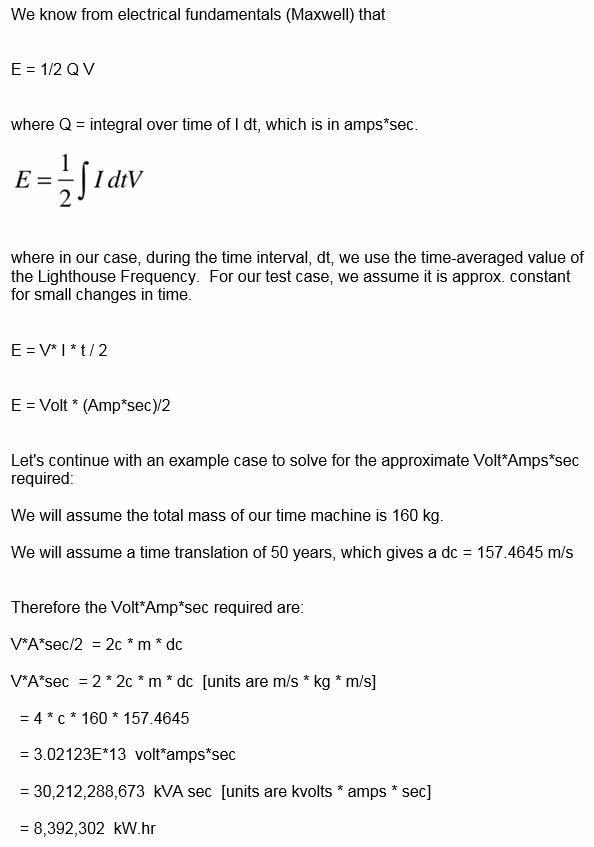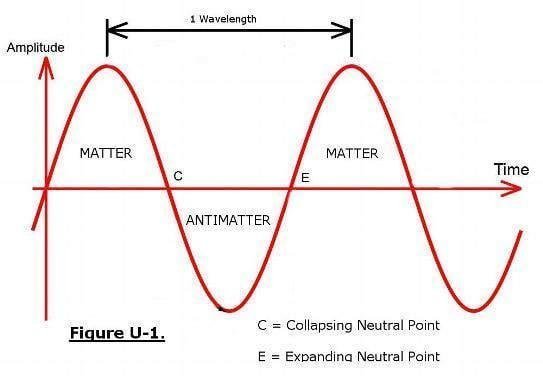Time Travel - An Approximate mathematical solution
Abstract
This short technical note describes an approximate mathematical solution for Time Travel involving relativity and very brief time intervals. Time Travel is made possible by exploiting the fact that our universe literally blinks off and on at a very high frequency. Limitations of the solution are discussed including possible error sources. Assumptions are made for small changes in the speed of light and for the Lighthouse Frequency, which has been described in previous papers. This paper will only be meaningful to those with a background in calculus, physics or engineering. The math is derived by taking Einstein's equation, E=mc^2, and taking the partial derivative with respect to time. Readers will note that the speed of light is not constant per Dr Daniel Gezari's important paper; "Lunar Laser Ranging Test on the Invariance of C." Each reader must comprehend that our universe literally blinks off and on, approximately 1 trillion times every second (1.1 THz). For those unconvinced that our universe is blinking - please see the related ebook, "The First Periodic Table for Elementary Particles," which provides compelling mathematical evidence.
#BlinkingUniverse
This short technical note describes an approximate mathematical solution for Time Travel involving relativity and very brief time intervals. Time Travel is made possible by exploiting the fact that our universe literally blinks off and on at a very high frequency. Limitations of the solution are discussed including possible error sources. Assumptions are made for small changes in the speed of light and for the Lighthouse Frequency, which has been described in previous papers. This paper will only be meaningful to those with a background in calculus, physics or engineering. The math is derived by taking Einstein's equation, E=mc^2, and taking the partial derivative with respect to time. Readers will note that the speed of light is not constant per Dr Daniel Gezari's important paper; "Lunar Laser Ranging Test on the Invariance of C." Each reader must comprehend that our universe literally blinks off and on, approximately 1 trillion times every second (1.1 THz). For those unconvinced that our universe is blinking - please see the related ebook, "The First Periodic Table for Elementary Particles," which provides compelling mathematical evidence.
#BlinkingUniverse
Original copyright 2013
Revision 8b – 10 March 2019
Houston, Texas, U.S.A.
TIME TRAVEL: AN APPROXIMATE MATHEMATICAL SOLUTION
Background Information
Figure 1. Basic vehicle design from; “Prototype Design for a Time Machine.”
Everything in a physical universe has a natural, resonant frequency – including the universe itself. That frequency is approximately 1.1 THz and can be utilized as a carrier wave. [10]
This can be called a vibration, a blinking, or a frequency, but perhaps a better explanation, in our terms - the entire physical universe is newly constructed and then collapses to a single point at approximately 1.1 trillion times each second, IN OUR TERMS (this must be emphasized). At the moment of collapse, there is no distance between galaxies - instant communication and instant travel are possible. (In larger terms of 5th dimensional space, all of time is simultaneous, and there is no blinking. From that vantage point, we would perceive all probabilities and all time as simultaneous.)
This resonant frequency is named the "Lighthouse Frequency."
By applying a precise electric charge to a vehicle (such as a spacecraft) while vibrating the external metal skin at the Resonant Frequency of the universe - a vehicle can instantly jump thru time or space. The precise volts, amps, and phase angle determine where in spacetime the vehicle jumps. This implies then, the difference between 2 points in SPACE is defined by electric charge, not distance. And the difference between 2 points in TIME is also defined by electric charge, not seconds or years.
This idea can be compared to using a strobe light on a rotating fan to "stop" the blades - from the perspective of the strobe, the fan is not moving and it is possible to "jump" between the blades. The jump, in our terms, is caused by a simple electric charge.
It is noted that Dr Daniel Gezari, NASA Scientist, made extremely precise measurements of the speed of light, finding that it is faster than the "known constant." (Daniel Gezari, "Lunar Laser Ranging Test of the Invariance of C")
Mathematical Derivation:
Revision 8b – 10 March 2019
Houston, Texas, U.S.A.
TIME TRAVEL: AN APPROXIMATE MATHEMATICAL SOLUTION
Background Information
Figure 1. Basic vehicle design from; “Prototype Design for a Time Machine.”
Everything in a physical universe has a natural, resonant frequency – including the universe itself. That frequency is approximately 1.1 THz and can be utilized as a carrier wave. [10]
This can be called a vibration, a blinking, or a frequency, but perhaps a better explanation, in our terms - the entire physical universe is newly constructed and then collapses to a single point at approximately 1.1 trillion times each second, IN OUR TERMS (this must be emphasized). At the moment of collapse, there is no distance between galaxies - instant communication and instant travel are possible. (In larger terms of 5th dimensional space, all of time is simultaneous, and there is no blinking. From that vantage point, we would perceive all probabilities and all time as simultaneous.)
This resonant frequency is named the "Lighthouse Frequency."
By applying a precise electric charge to a vehicle (such as a spacecraft) while vibrating the external metal skin at the Resonant Frequency of the universe - a vehicle can instantly jump thru time or space. The precise volts, amps, and phase angle determine where in spacetime the vehicle jumps. This implies then, the difference between 2 points in SPACE is defined by electric charge, not distance. And the difference between 2 points in TIME is also defined by electric charge, not seconds or years.
This idea can be compared to using a strobe light on a rotating fan to "stop" the blades - from the perspective of the strobe, the fan is not moving and it is possible to "jump" between the blades. The jump, in our terms, is caused by a simple electric charge.
It is noted that Dr Daniel Gezari, NASA Scientist, made extremely precise measurements of the speed of light, finding that it is faster than the "known constant." (Daniel Gezari, "Lunar Laser Ranging Test of the Invariance of C")
Mathematical Derivation:
This amount of energy is placed on the shell housing of the Time Machine while simultaneously vibrating the skin at the Lighthouse Frequency - which is done by using a hyfrecator-type device. The Lighthouse Frequency is embedded in the discharge in the form of a square wave, for example.
CONCLUSIONS
An approximate solution has been provided to determine the amount of energy required for time travel. The concept is based upon a blinking universe. A sample problem has been analyzed assuming a time machine with a mass of 160 kg and a time translation of 50 years. [9]
This document is a living document. The author reserves the right to make corrections and changes.
REFERENCES
1. Albert Einstein (1905) "Zur Elektrodynamik bewegter Körper", Annalen der Physik 17: 891; English translation “On the Electrodynamics of Moving Bodies” by George Barker Jeffery and Wilfrid Perrett (1923).
2. Richard Lighthouse, “Preliminary Investigation into the Nature of Time,” lulu.com, ebookmall.com; 2010.
3. Richard Lighthouse, “Relativity and Discrete Time Intervals,” amazon.com, 2012.
4. Seth (Jane Roberts) Early Sessions, Book 2, Session 60, 1964. “Matter is continually created, but no particular physical object is in itself continuous... No particular physical particle exists for any amount of time. It exists and disappears, and is instantaneously replaced by another.”
5. Seth (Jane Roberts) Unknown Reality, Volume 1, Session 684, 18 February 1974. “The world literally blinks off and on. This reality of fluctuation in no way bothers your own feeling of consistency, however. The "holes of nonexistence" are plugged up by the process of selectivity.”
6. www.godandscience.org/youngearth/speedlight.html
Reference excel spreadsheet data.
7. Daniel Gezari, Lunar Laser Ranging Test of the Invariance of C, National Aeronautics and Space Administration (NASA), 2009. Value of c determined to be 299,792,658 +/- 10 m/sec. [different than the traditional constant value]
8. Seth (Jane Roberts) Early Sessions, Session 135, 1965. "Such electrical realities then, through the strength of their intensities and their particular range, are projected into some fields, but not projected into others. Any so-called travel through time involves then, a traveling through such intensities.” [Author’s note: Electrical Intensities = Volts, Range = Amp*sec]
9. Richard Lighthouse, “Prototype Design for a Time Machine,” smashwords.com, 2013.
10. Richard Lighthouse, “Experimental Method for Determination of the Lighthouse Frequency,” smashwords.com, Rlighthouse.com; 2013.
Acknowledgments
Acknowledgments: The author gratefully acknowledges Seth, Jane Roberts, and Rob Butts for their significant contributions. Also thanks to Dr J. Jerke and Dr R. Bryan for their comments on the math, although they do not necessarily agree with the views expressed in this paper.
About: The author holds a Master of Science (M.Sc.) degree from Stanford University. He can be reached: RLighthouse – at – protonmail.com
Funding
This research was supported with a grant from the Foundation Opposed to Academic Puffery (FOAP).
APPENDIX
If we assume that we will build up this electric charge on a capacitor, and then discharge it within a single cycle of the Lighthouse Frequency:
@ 10 cents per kWatt*hr
The electricity to make a time translation of 50 years for a single traveler will cost approximately:
= 3.02123E*13 /1000/3600 =
$ 839,230 or nearly 1 Million USD.
Figure 2. The cycle of our universe.




